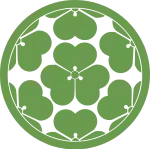Chōsokabe clan
Chōsokabe clan (長宗我部氏, Chōsokabe-shi), also known as Chōsokame (長曾我部、長宗我部), was a Japanese samurai kin group. Over time, they were known for serving the Hosokawa clan, then the Miyoshi clan and then the Ichijo clan.[1]
| Chōsokabe clan 長宗我部氏 | |
|---|---|
 The emblem (mon) of the Chōsokabe clan | |
| Home province | Tosa |
| Parent house | Hata clan (秦氏) |
| Final ruler | Chōsokabe Morichika |
| Ruled until | 1615, Battle of Osaka |
History

A family tree of Chōsokabe clan.
The clan claims descent from Qin Shi Huang (d. 210 BCE), the first emperor of a unified China.
The clan is associated with Tosa Province in modern-day Kōchi Prefecture on the island of Shikoku.[2] Chōsokabe Motochika, who unified Shikoku, was the twenty-first daimyō (or head) of the clan.
In their early history of the Sengoku period, Chōsokabe Kunichika's father Kanetsugu, was killed by the Motoyama clan in 1508. Therefore, Kunichika was raised by the aristocrat Ichijō Husaie of the Ichijō clan in Tosa Province. Later, towards the end of his life, Kunichika took revenge on the Motoyama clan and destroyed them with the help of the Ichijō in 1560. Kunichika would go on to have children, including his heir and the future Daimyo of the Chōsokabe, Motochika, who would go on to unify Shikoku.
First, the Ichijō family was overthrown by Motochika in 1574. Later, he gained control of the rest of Tosa due to his victories at the Battle of Watarigawa in 1575. He then also destroyed the Kono and the Soga clan. Over the ensuing decade, he extended his power to all of Shikoku in 1583. However, in 1585, Toyotomi Hideyoshi (Oda Nobunaga's successor) invaded that island with a force of 100,000 men, led by Ukita Hideie, Kobayakawa Takakage, Kikkawa Motonaga, Toyotomi Hidenaga, and Toyotomi Hidetsugu. Motochika surrendered, and forfeited Awa, Sanuki, and Iyo Provinces; Hideyoshi permitted him to retain Tosa.
Under Hideyoshi, Motochika and his son Chōsokabe Nobuchika participated in the invasion of neighboring Kyūshū, in which Nobuchika died. In 1590, Motochika led a naval fleet in the Siege of Odawara, and also fought in the Japanese invasions of Korea along with Toyotomi Hideyoshi in 1592.
After Motochika died in 1599 at age 61, the next clan leader was his son Chōsokabe Morichika. He led the clan forces in support of the Toyotomi at the Battle of Sekigahara. After 1600, the Chōsokabe were removed as daimyo of Tosa.[2]
After the Siege of Osaka in 1615, Morichika was executed and the clan was ended as a political and military force.[2]
Among the retainers to the clan were Kōsokabe Chikayasu, Tani Tadasumi, Hisatake Chikanao, Yoshida Takayori, Yoshida Shigetoshi, Yoshida Masashige.
Shirō Sōkabe, the 19th century missionary, was a descendant of the Chōsokabe clan.[3]
Clan Heads
- Chōsokabe Yoshitoshi (長宗我部能俊, ? – ? )
- Chōsokabe Toshimune (長宗我部俊宗, ? – ? )
- Chōsokabe Tadatoshi (長宗我部忠俊, ? – ? )
- Chōsokabe Shigeuji (長宗我部重氏, ? – ? )
- Chōsokabe Ujiyuki (長宗我部氏幸, ? – ? )
- Chōsokabe Kiyoyuki (長宗我部満幸, ? – ? )
- Chōsokabe Kanemitsu (長宗我部兼光, ? – ? )
- Chōsokabe Shigetoshi (長宗我部重俊, ? – ? )
- Chōsokabe Shigetaka (長宗我部重高, ? – ? )
- Chōsokabe Shigemune (長宗我部重宗, ? – ? )
- Chōsokabe Nobuyoshi (長宗我部信能, ? – ? )
- Chōsokabe Kaneyoshi (長宗我部兼能, ? – ? )
- Chōsokabe Kanetsuna (長宗我部兼綱, ? – ? )
- Chōsokabe Yoshishige (長宗我部能重, ? – ? )
- Chōsokabe Motochika (長宗我部元親, ? – ? )
- Chōsokabe Fumikane (長宗我部文兼, ? – ? )
- Chōsokabe Motokado (長宗我部元門, ? –1471)
- Chōsokabe Katsuchika (長宗我部雄親, ? –1478)
- Chōsokabe Kanetsugu (長宗我部兼序, ? –1518)
- Chōsokabe Kunichika (長宗我部国親, 1504–1560)
- Chōsokabe Motochika (長宗我部元親, 1539–1599)
- Chōsokabe Morichika (長宗我部盛親, 1575–1615)
- Chōsokabe Moritsune (長宗我部盛恒, ? –1615)
Popular culture
The Chōsokabe clan and Chōsokabe Motochika in particular are featured in many franchises set in the Sengoku period such as Sengoku Basara, Samurai Warriors, Nioh 2, Nobunaga's Ambition and Total War: Shogun 2. Portrayals vary somewhat and some of them are very fictionalized. For example, Total War: Shogun 2 portrays the clan as master archers while Sengoku Basara portrays them as pirates.
See also
- Okō Castle Castle ruins.(Home castle of Chōsokabe clan.)
- Ichiryō gusoku, a group of farmer-samurai who served the Chōsokabe clan
References
- Papinot, Jacques Edmond Joseph. (1906). Dictionnaire d’histoire et de géographie du Japon; Papinot, (2003). "Chōsokabe," Nobiliare du Japon, p. 4 [PDF 8 of 80]; retrieved 2013-5-4.
- Louis Frédéric (2002). Japan Encyclopedia. Harvard University Press. p. 124. ISBN 978-0-674-01753-5.
- Imamura, Rio (November 21, 2012). "Samurai Missionary". Discover Nikkei. Retrieved 2018-12-27.